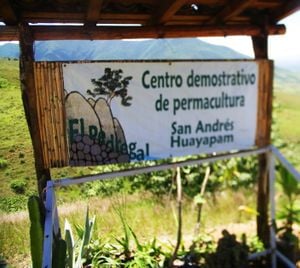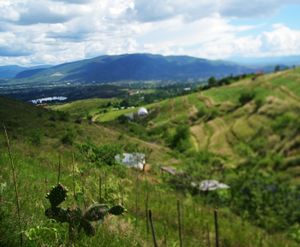
Pedregal is the Permaculture Demonstration Center in San Andres Huayapam and it is a project from the Institute of Nature and Society of Oaxaca (INSO). The demonstration center began in 2005 in order to: regenerate the aquifer capacity, provide opportunities to families in the surrounding communities for sustainable production, and build a center of experimentation and research in organic farming techniques, restoration of canyons, and integrated water management.
Today we have an ecological house and multiple projects in order to better manage water use, protect soils, produce organic foods, and save energy. We have planted ground covers, fruit trees, native plants, cactus, corn, and vegetables. We are also raising bees, fish and poultry. In the long run the project will have other demonstrative purposes including: water treatment and purification, autonomous generation of energy, waste management, food production, habitat and conservation of the environment.

Background[edit | edit source]
Aguaxaca is a comprehensive strategy of partnership between civil society, the three levels of government, private groups and communities to conserve the region's natural resources that ensure water for all and options for social improvement to both rural communities and the inhabitants in the city.
Regenerating the Aquifer[edit | edit source]
Rain Water Catchment[edit | edit source]
These systems can be constructed in many areas, both to increase the regeneration of the loca aquifer with rainwater and to reduce the soil erosion from rainfall. At Pedregal they have a mix of: systems that use roofs and systems simply using sloped terrain.
Micro Filter Dams[edit | edit source]
Microfilter dams are small dams with gabions, made of stone or ferocement, that can help stop sand, silt, gravel, and rocks which are carried in the current. These micro filter dams reduce erosion and give more time for water to filter into the groundwater. The design tries to recreate what happens naturally in a healthy stream, which is the formation of pools and steps, which in turn serve as habitat to many plants and animals.
Reforestation[edit | edit source]
Forests help stabilize soil, prevent erosion into water ways, and slows water flow from rain so that there is increased time for percolation into aquifers as well as offering many other ecosystem services. To regenerate ecosystems it is useful imitate nature: plant native plants - not only trees but also shrubs and herbs - and to encourage natural regeneration in places that are not too damaged. In other highly deteriorated areas Petegral starts by stabilizing the soil before planting any plant. The reforestation plan includes how to care for the plants as well as how to water them in when planting.
Organic Farming[edit | edit source]
Greenhouses[edit | edit source]
Allow intensive agriculture through the control of light, heat and moisture. Petegral uses a PVC greenhouses, which is cheap and easy to install.
Terraces and Ditches[edit | edit source]
Prevent erosion on steep slopes and create areas for farming. Terraces and ditches are dug according to the contour of the site and the terraces leave an a edge over each trench. Water rather then flowing straight down hill follows the edges of these terraces slowing down the water and preventing massive erosion.If vetiver (a tall perennial grass) is planted in the mounds it helps prevent even more erosion. The distance between these trenches depends on the slope.
Gabions and soil traps[edit | edit source]
In sloping land where vegetation has been lost these gabions are useful stone barriers made of cyclone mesh to prevent the flow of streams and rains from washing away the soil. The position of the gabions and traps and the distance between them depend on the slope, the tip of land and how it rains.
Nursery[edit | edit source]
They collect seeds and cuttings to grow local plants, fruit trees and vetiver grass for revegetation efforts. These plants also support regeneration in the local community regeneration and the plants are produced on a small scale in a bag or bedding before transplanting.
Irrigation System[edit | edit source]
Agriculture can use a lot of water. Pressurized sprinkler systems, micro sprinklers, and drip systems make watering more efficient and saves a lot of water. Petegral takes advantage of gravity to obtain the necessary pressure for sprinkler systems and uses drip irrigation in the greenhouses where baby plants are starting out.
Human and Ecological Health[edit | edit source]
Ecological dry toilets at Pedregal[edit | edit source]
They are a cheap and efficient option for sanitation. They save water, produce good quality compost and reduce the incidence of intestinal infections and other diseases.